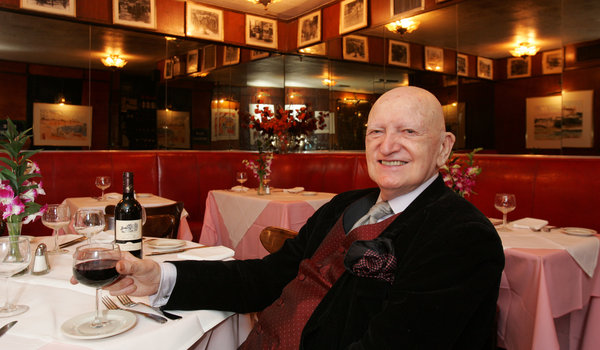Robert Treboux, the owner of the venerable Manhattan bistro Le Veau d’Or and one of the last of the influential chefs and restaurant owners who came out of Le Pavillon and put their stamp on fine dining in New York for decades, died on Wednesday in Manhattan. He was 87.
His death was confirmed by his daughter Catherine Treboux.
Mr. Treboux bought Le Veau d’Or in 1985, capping a long culinary career in New York. After waiting on tables in the 1950s at Le Pavillon, the legendary restaurant that epitomized formal French cuisine, he opened several highly regarded restaurants of his own before acquiring Le Veau d’Or, a tiny bistro on East 60th Street that dates to 1937.
In its heyday, from the 1940s through the 1960s, Le Veau d’Or (“The Golden Calf” in French) counted among its patrons Orson Welles, Marlene Dietrich, Grace Kelly and Oleg Cassini. By the time Mr. Treboux took it over, it had settled into a dignified old age, supported by a fiercely loyal, older clientele who loved its unbending traditionalism and adored Mr. Treboux for refusing to change its menu, its décor or its highly personal style of management.
Longtime patrons — some, like the food writer Barbara Kafka, have been dining at Le Veau d’Or for half a century — wanted continuity and familiarity, not innovation, and that is what Mr. Treboux delivered, with classics like celery rémoulade, trout meunière, tripe à la mode de Caen and boeuf bourguignon offered on a brief menu that has barely budged since the 1930s.
In “The United States of Arugula,” his history of modern food trends, David Kamp called the restaurant “an extraordinary time warp.” It was, he wrote, “the last place in New York where you can still get uncompromised Escoffier cuisine and have your roast carved tableside by a man who worked directly under Soulé.”
For Mr. Treboux, “time warp” counted as high praise. “We want to keep it what it is, which is what people want,” he told The New York Sun in 2006. Diners in search of trends, he suggested, could go “to other places that have the plate with the little bit of food in the middle.”
Robert Marcel Treboux was born on Oct. 21, 1924, in Vinzier, in the Savoy region of France, where his parents were dairy farmers. At 16 he went to Paris to work in a hotel that one of his cousins managed, and he later rose from waiter to captain as he put in stints at La Selle in Paris, the Palace in Madrid and Claridge’s in London.
While working on the French liner Liberté, he made the acquaintance of a New York judge, who sponsored his entry into the United States. After working for five years at Le Pavillon, he moved to the front of the house at Maud Chez Elle, a critic’s darling at the time.
Keen to run his own show, he opened Le Manoir at 56th Street and Park Avenue in the late 1950s and went on to create two other restaurants in the East 50s, Le Clos Normand and La Rotisserie Française, one of the first Manhattan restaurants with an open kitchen. La Rotisserie Française was also a favored dining spot for a group of sportswriters and fans who created a fantasy game that they called, in a nod to the restaurant, Rotisserie League Baseball.
Mr. Treboux sold La Rotisserie to developers, who erected Citicorp Center and soon acquired Le Veau d’Or. He held onto Le Manoir for several years while his daughter Catherine managed his new acquisition.
In 1991 he sold Le Manoir and installed himself permanently at Le Veau d’Or, steering it on its slow, steady course. “We’re not pushing business,” he told The Sun. “We’re fine with our regulars. That’s good enough for me. ‘Après moi, le déluge.’ ”
In addition to his daughter Catherine, Mr. Treboux is survived by his wife, Julienne; another daughter, Dominique Treboux; a brother, Jean; and four grandchildren.
Mr. Treboux was both owner and tenant at Le Veau d’Or, living above the restaurant, which he defined, and which defined him.
“I take a nap in the afternoon, I come down for dinner, then I close the place,” he told The Sun. “To me, that’s living. Going on vacation is not living. This is my life. I like to talk. I like people.” [NYT]


